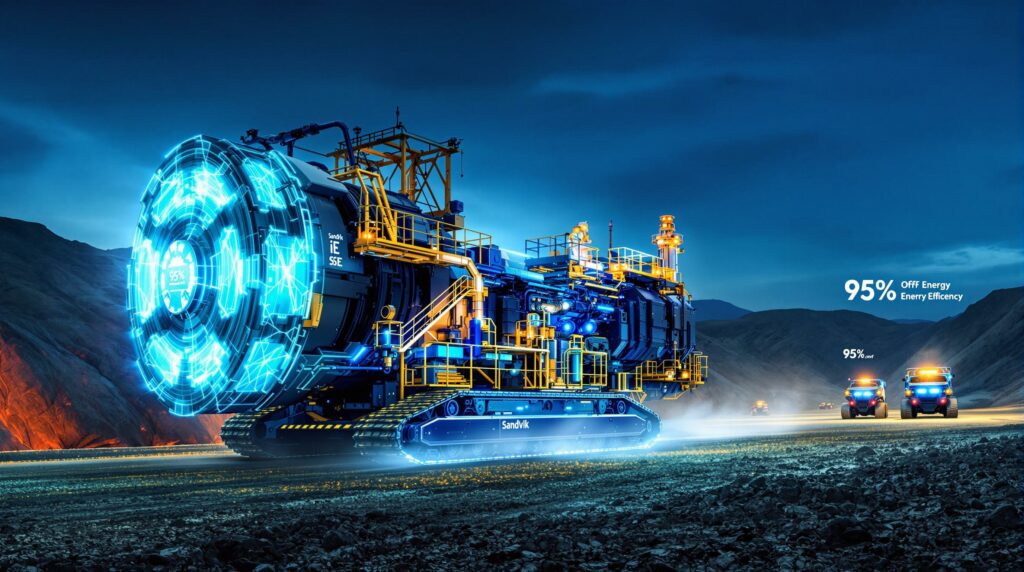The Future of Mining is Electric: Revolutionizing the Industry with Sustainable Technology
The mining industry is undergoing a profound transformation as companies increasingly adopt electric technology to replace traditional diesel-powered equipment. This shift is particularly evident in rotary drilling operations, where electric-powered solutions are setting new standards for efficiency, sustainability, and operational performance. Discover how the Sandvik rotary iE drills exemplify this revolution with their groundbreaking efficiency and innovative design.
What Are Rotary Drills and Why Are They Important in Mining?
Rotary drills play a fundamental role in modern mining operations, serving as the crucial first step in the resource extraction process. These powerful machines create the blast holes necessary for accessing valuable minerals and materials beneath the earth's surface.
The Critical Role of Rotary Drills in Surface Mining
Surface mining operations rely heavily on rotary drills to create precise blast holes that enable efficient resource extraction. These sophisticated machines drill deep into the earth's surface, creating pathways for explosives that fragment rock formations and expose valuable minerals. The effectiveness of these initial drilling operations directly impacts every subsequent stage of the mining process.
Rotary drills must operate with exceptional precision and reliability, often in harsh environmental conditions ranging from extreme heat to freezing temperatures. Their performance directly affects production schedules, operational costs, and ultimately, a mine's profitability.
Traditional Challenges with Diesel-Powered Rotary Drills
Conventional diesel-powered rotary drills have presented mining operations with numerous persistent challenges:
- High fuel consumption – Diesel drills typically consume substantial amounts of fuel, creating significant ongoing operational expenses
- Extensive maintenance requirements – Complex mechanical systems require frequent service intervals
- Limited service life – Higher wear rates on critical components necessitate more frequent replacements
- Environmental impact – Diesel emissions contribute to air pollution and carbon footprint concerns
- Health considerations – Noise, heat, and vibration from diesel engines create challenging working conditions for operators
These limitations have prompted mining companies to seek more sustainable, efficient alternatives that can overcome these longstanding challenges while maintaining or improving operational performance.
What Makes the Sandvik Rotary iE Series Revolutionary?
The Sandvik rotary iE series represents a significant leap forward in mining technology, offering a suite of advantages that set it apart from traditional diesel-powered alternatives. These electric-powered drills deliver substantial improvements across multiple performance metrics.
Breakthrough Energy Efficiency
The most striking feature of the Sandvik rotary iE series is its remarkable 95% energy efficiency, as reported by Australian Mining in August 2025. This represents a quantum leap compared to diesel alternatives, which typically achieve significantly lower efficiency rates due to inherent limitations of combustion engines.
"Sandvik iE-series drill rigs use the same modular platform as our diesel-powered rotary rigs but with the added environmental benefits of mining electrification" – Nellaiappan Subbiah, Sandvik Mining product manager rotary drills
This exceptional efficiency translates directly into lower operational costs and a substantially reduced environmental footprint. Mine operators can achieve the same or better drilling performance while consuming significantly less energy, addressing both economic and sustainability objectives simultaneously.
Extended Service Life and Reliability
Perhaps one of the most compelling advantages of the Sandvik rotary iE series is its durability. These electric drills offer triple the service life compared to diesel-powered alternatives, according to Australian Mining's August 2025 report. This dramatic extension of operational lifespan fundamentally changes the total cost of ownership calculation for mining companies.
The extended service life results from several factors:
- Fewer moving parts subject to wear and tear
- Reduced vibration stress on components
- Elimination of high-temperature operation associated with combustion engines
- More precise control systems that prevent overloading
This exceptional longevity not only reduces replacement costs but also minimizes operational disruptions and maintenance downtime, allowing for more consistent production schedules.
Modular Design Advantages
One of the most innovative aspects of the Sandvik rotary iE series is its modular platform, shared with the company's diesel-powered rotary rigs. This strategic design decision provides numerous operational benefits:
- Operational familiarity – Operators already trained on diesel variants can transition seamlessly
- Simplified maintenance – Technicians can apply existing knowledge to many shared components
- Adaptable configurations – The platform can be customized for various mining conditions
- Field conversion capability – Existing diesel units can be converted to electric in the field
As Nellaiappan Subbiah, Sandvik Mining product manager rotary drills, explained to Australian Mining Review: "We now also offer customers the ability to convert a diesel-powered unit to a fully electrified version in the field. These innovative drills deliver superior performance, reliability and sustainability in the most demanding mining conditions."
This conversion capability provides mining operations with a flexible transition path toward electrification without requiring complete fleet replacement, allowing for strategic phasing of capital investments.
How Does Electrification Improve Mining Operations?
The transition to electric drilling technology delivers numerous operational improvements beyond the direct performance of the drilling equipment itself, creating positive ripple effects throughout mining operations.
Environmental Benefits of Electric Drilling
Electric drilling technology provides multiple environmental advantages that align with increasingly stringent regulatory requirements and corporate sustainability objectives:
- Zero direct emissions – No exhaust emissions during operation, improving air quality
- Reduced carbon footprint – Lower overall energy consumption translates to reduced greenhouse gas emissions
- Decreased noise pollution – Electric motors operate more quietly than diesel engines
- Minimal heat generation – Lower operating temperatures reduce thermal impact on surrounding environment
- Reduced vibration – Electric motors produce less vibration, decreasing ground disturbance
These environmental benefits help mining operations comply with tightening regulations while also supporting broader corporate social responsibility initiatives and sustainable mining transformation.
Health and Safety Improvements
The shift to electric drilling creates significantly healthier work environments for mining personnel:
- Elimination of diesel exhaust – Removes exposure to particulate matter and harmful gases
- Reduced noise levels – Decreases risk of noise-induced hearing damage and communication difficulties
- Lower heat exposure – Minimizes heat-related stress and fatigue for operators
- Decreased vibration – Reduces operator exposure to harmful vibration that can cause long-term health issues
These improvements can lead to reduced absenteeism, higher productivity, and lower healthcare costs while creating a more attractive workplace for recruiting and retaining qualified personnel.
Maintenance Cost Reduction
Electric systems offer substantial maintenance advantages that translate directly to lower operational costs:
- Simplified mechanical systems – Fewer moving parts requiring service or replacement
- Elimination of many fluids – No need for diesel fuel, reduced oil changes and disposal
- Predictive maintenance capabilities – Advanced monitoring systems allow for more precise service scheduling
- Extended service intervals – Longer periods between required maintenance activities
These maintenance benefits combine to reduce both planned and unplanned downtime, allowing for more consistent and reliable production schedules while decreasing overall operational costs.
What Technical Innovations Power the Sandvik iE Series?
The exceptional performance of the Sandvik rotary iE drills stems from several sophisticated technical innovations that address traditional challenges of electric equipment in mining environments.
Advanced Electric Power Systems
The Sandvik rotary iE drills feature sophisticated electric systems specifically engineered for mining applications:
- High-altitude compatibility – Robust electric power groups maintain performance even in challenging high-altitude environments
- Soft starter technology – Innovative soft starters minimize impact on mine power grids during startup, preventing disruptions to other equipment
- Multi-voltage and multi-frequency capabilities – Electric motors can operate across various power supply configurations, providing flexibility across different mining sites
- Optional cable reels – Available with ample capacity for connection to mine substations, simplifying power distribution logistics
These technical features ensure reliable operation even in remote or challenging mining environments where power infrastructure may be limited or unstable.
Intelligent Control Systems
The sophisticated DRi control system used across all Sandvik i-series rotary drills represents a significant advancement in drilling technology:
- Unified interface – Consistent user experience across all Sandvik i-series rotary drills reduces training requirements
- Advanced monitoring – Real-time tracking of performance metrics enables optimization and early problem detection
- Automated optimization – Intelligent adjustments to drilling parameters maximize efficiency and tool life
- Remote diagnostic capabilities – Technical issues can be identified and sometimes resolved without on-site service visits
This intelligent control system not only improves operational efficiency but also enables data collection for continuous improvement of drilling practices and long-term performance optimization. The integration of AI in drilling operations further enhances these capabilities.
How Can Mining Operations Transition to Electric Drilling?
The transition to electric drilling represents a significant operational shift for mining companies, requiring careful planning and implementation strategies to maximize benefits while minimizing disruption.
Integration with Existing Infrastructure
The Sandvik rotary iE series is designed for seamless integration into existing mining operations:
- Standard electrical compatibility – Works with conventional mine electrical systems without specialized components
- Flexible power requirements – Adaptable to various voltage and frequency specifications
- Minimal site preparation – Limited additional infrastructure needed beyond power distribution
- Staged implementation – Can operate alongside existing diesel equipment during transition periods
This integration flexibility allows mining operations to adopt electric drilling technology without disruptive overhauls to existing infrastructure or processes.
Conversion Options for Current Equipment
Mining operations have multiple pathways to electrification, allowing for strategic planning based on capital availability and operational priorities:
- Field conversion program – Existing diesel-powered Sandvik units can be converted to fully electric versions
- Gradual fleet transition – Phased replacement of aging diesel equipment with new electric alternatives
- Hybrid operational approaches – Strategic deployment of electric units for specific applications or areas while maintaining diesel equipment elsewhere
The field conversion capability highlighted by Sandvik's Nellaiappan Subbiah represents a particularly valuable option for operations seeking to accelerate their sustainability transition while managing capital expenditures.
Expert Support and Service
Successful implementation of electric drilling technology depends on comprehensive support systems:
- Specialized service teams – Technicians trained specifically for electric drilling equipment
- Operator training programs – Structured education to maximize the benefits of new technology
- Performance optimization services – Ongoing analysis and adjustment to achieve peak efficiency
- Remote monitoring and support – Continuous oversight to identify and address potential issues early
This support ecosystem ensures that mining operations can fully realize the potential benefits of electric drilling technology while minimizing implementation challenges and operational disruptions.
What Are the Economic Benefits of Electric Drilling Technology?
The economic case for electric drilling technology extends beyond the immediate operational advantages, encompassing a comprehensive total cost of ownership perspective that reveals substantial long-term benefits.
Total Cost of Ownership Analysis
When evaluating the economic impact of electric drilling, operations should consider multiple factors beyond the initial purchase price:
- Energy cost differential – Electric power typically costs significantly less than equivalent diesel fuel
- Maintenance expense reduction – Fewer service requirements translate to lower ongoing costs
- Extended equipment lifespan – Triple the service life means delayed replacement capital expenditures
- Reduced downtime costs – More reliable operation minimizes production losses
- Potential regulatory compliance savings – Avoidance of carbon taxes or emissions penalties
While specific figures would vary by operation, the combination of these factors typically results in a favorable total cost of ownership calculation for electric drilling technology, particularly when analyzed over a 5-10 year timeframe. The decarbonisation benefits extend far beyond immediate operational advantages.
Productivity Improvements
Electric drilling technology can enhance operational productivity through several mechanisms:
- Consistent performance – Electric motors maintain optimal power delivery regardless of altitude or temperature
- Reduced maintenance interruptions – Less frequent service requirements mean more operational uptime
- Improved reliability – Fewer breakdowns and failures in challenging conditions
- Enhanced operator performance – Better working conditions with less noise, heat, and vibration lead to improved focus and productivity
These productivity enhancements compound the direct cost benefits of electric technology, further strengthening the business case for adoption.
How Does Electric Drilling Support Sustainability Goals?
As mining companies increasingly embrace environmental, social, and governance (ESG) principles, electric drilling technology provides tangible support for sustainability initiatives.
Alignment with ESG Objectives
The adoption of electric drilling technology directly supports key ESG pillars:
- Environmental responsibility – Reduced emissions, noise, and resource consumption
- Social impact – Improved working conditions and community relations through reduced pollution
- Governance standards – Demonstrable commitment to sustainable operations and future-focused investment
This alignment helps mining companies respond to growing pressure from investors, regulators, and customers to demonstrate meaningful progress toward sustainability goals.
Contribution to Carbon Reduction Targets
Electric drilling directly contributes to carbon reduction initiatives through multiple pathways:
- Elimination of Scope 1 emissions – Direct emissions from diesel combustion are completely removed
- Potential Scope 2 reduction – When paired with renewable energy solutions, overall carbon footprint is dramatically reduced
- Lifecycle emissions benefits – Extended service life means fewer manufacturing emissions from replacement equipment
- Enabling technology for net-zero mining – Critical component in broader mine electrification strategies
As mining companies establish and pursue ambitious carbon reduction targets, electric drilling technology represents a high-impact opportunity to achieve meaningful progress while maintaining or improving operational performance.
FAQ: Electric Rotary Drills in Mining
How do electric rotary drills compare to diesel in performance?
Electric rotary drills match or exceed the performance capabilities of diesel equivalents while offering superior efficiency and reliability. The Sandvik rotary iE series maintains full drilling capacity while achieving 95% energy efficiency and triple the service life of diesel alternatives. The precise control offered by electric motors actually enables more consistent performance across varying conditions, including high-altitude operations where diesel engines typically lose efficiency.
What infrastructure is needed to support electric drilling equipment?
Mining operations require reliable electrical infrastructure to support electric drilling equipment, including appropriately sized substations, distribution systems, and suitable cabling. The Sandvik rotary iE series offers flexibility through multi-voltage and multi-frequency capabilities, along with optional cable reels for connection to mine substations. The soft starter technology minimizes the impact on power grids during startup, reducing infrastructure requirements compared to less sophisticated electric equipment.
Can existing diesel drills be converted to electric?
Yes, as confirmed by Nellaiappan Subbiah of Sandvik Mining, the company offers field conversion options that transform diesel-powered units into fully electrified versions. This capability provides significant flexibility for mining operations transitioning to electric fleets, allowing them to extend the useful life of existing equipment while still achieving sustainability objectives. The modular platform design of Sandvik's rotary drills specifically enables this conversion capability.
What is the typical return on investment for electric drilling technology?
While the initial investment in electric drilling technology may be higher than diesel alternatives, the return on investment typically becomes favorable when accounting for reduced operational costs, extended service life, and decreased maintenance requirements. The combination of energy cost savings, maintenance reductions, and triple service life creates a compelling economic case, particularly for operations with reliable power infrastructure and moderate to high diesel fuel costs.
The Future of Mining is Electric
The future of mining is undeniably electric, with technologies like the Sandvik rotary iE drills leading the transformation toward more sustainable, efficient, and economically viable operations. As the industry continues to evolve in response to environmental challenges, regulatory pressures, and economic imperatives, electric drilling technology represents not merely an alternative to traditional methods but a superior approach that delivers benefits across multiple dimensions.
By embracing innovations like the Sandvik rotary iE series, mining companies can simultaneously address sustainability objectives, operational challenges, and economic pressures while positioning themselves for long-term success in an increasingly carbon-conscious global economy. The revolutionary capabilities of these electric drills demonstrate that environmental responsibility and operational excellence can go hand in hand, creating a new paradigm for the mining industry.
Want to Catch the Next Big ASX Mineral Discovery?
Discover how to gain immediate insights into significant ASX mineral discoveries before the broader market, powered by the proprietary Discovery IQ model from Discovery Alert. Understand the substantial returns potential from major discoveries by exploring our dedicated discoveries page and begin your 30-day free trial today.




